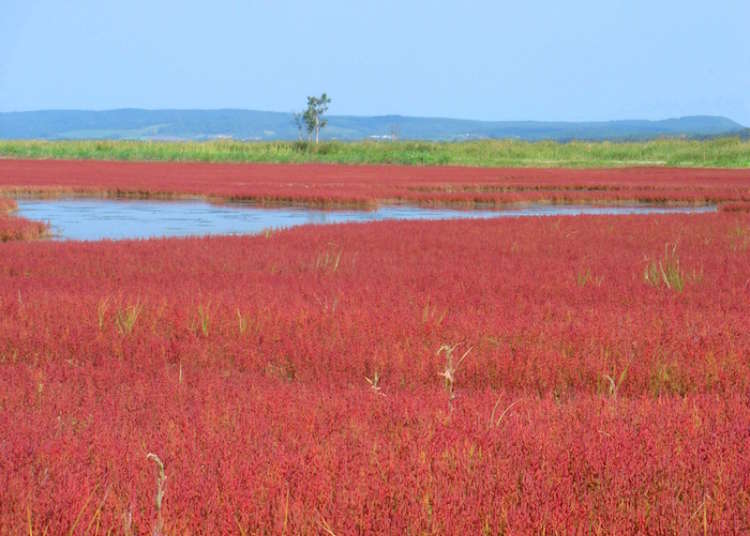
Roll Out the Red Carpet! Japan's North Has Breathtaking Fields of 'Coral Grass'
- Written by: Minna no Kotoba Sha
The changing leaves of autumn are one of Japan's most distinguishable markers of their four seasons, but is there something that goes even beyond the traditional foliage-viewing spots such as mountains and forests?
There is, and it's called 'coral grass,' a vividly-tinted, red field of grass that stretches into a beautiful expanse under the blue autumn sky comparable to a carpet of crimson. Here we'll introduce you to four towns in Japan with this gorgeous red grass.
Coral Grass: East Hokkaido's Fall Feature
Coral grass is an annual plant that grows to a height of about 15-30 centimeters. It's official name is Akkeshisou in Japanese (common glasswort in English). It was given its Japanese name because it was discovered around Lake Akkeshi, Kakijima Island, located in the eastern Pacific coastal town of Akkeshi.
When autumn comes around, the fleshy stalks branch out from the nodes and turn red, giving the grass an appearance similar to a coral reef, hence the nickname 'coral grass.'
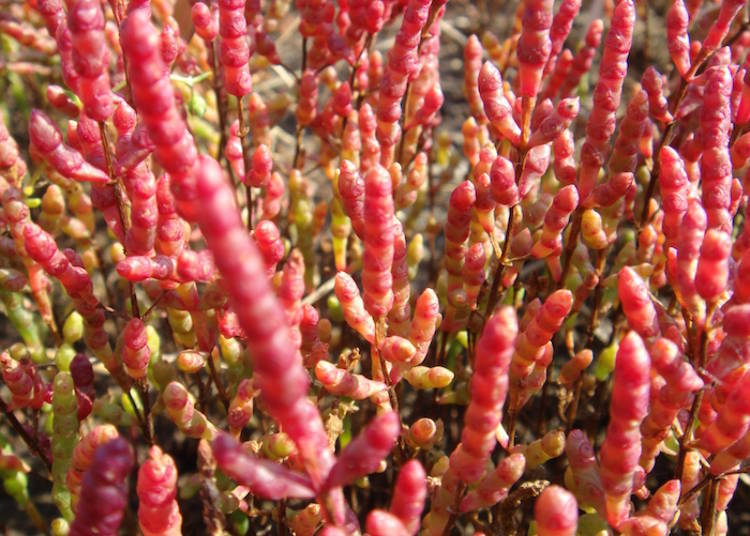
Coral grass thrives in salty environments such as wetlands that receive plenty of seawater from the incoming tides. Along the Sea of Okhotsk coast of Hokkaido lie many lakes that formed as remnants of the separated seas, and are home to plenty of coral grasses. The prime viewing time may vary depending on location and time of the year, but falls within the range of late August to early October.
Lake Notoro: Japan's Finest Coral Grass
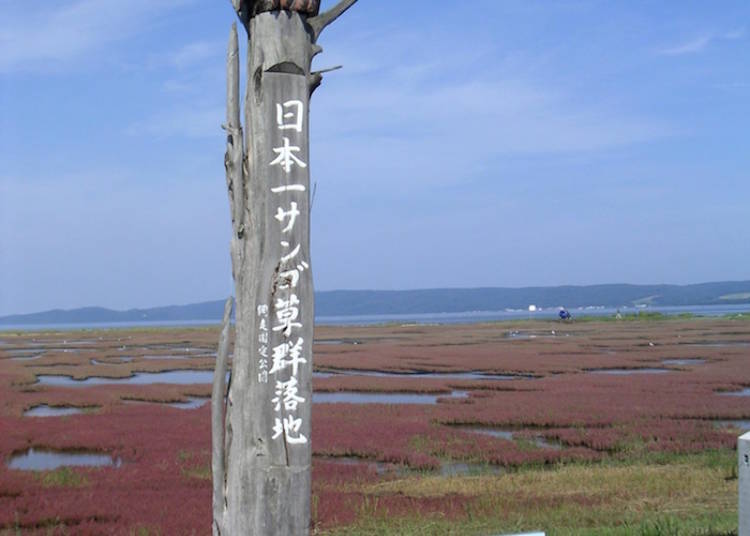
Lake Notoro in Abashiri City is said to house the largest expanse of coral grass in Japan. It is about 20 minutes by car or bus west of Abashiri Station, and can be accessed via Routes 39 and 238.
Though once facing endangerment of shrinkage due to the drying up of the wetlands, thanks to serious environmental protection efforts, this vast land now stretches out to about 3.8 hectares of land, creating a beautifully dyed red carpet that attracts tons of tourists and visitors mid-September every year.
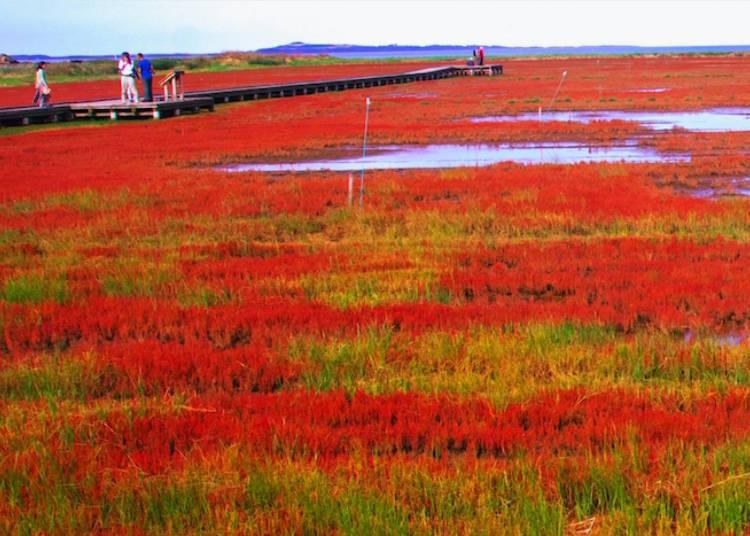
Because the coral grass is so highly protected, you cannot walk directly into it. Instead, there is a wooden pathway that cuts through the center of the fields that you can walk on. The color of the sky is reflected on the surface of the water, creating a stunning contrasted view that you can enjoy on clear days.
-
Ubaranai SANGO Grassland卯原内サンゴ草群落地
- Address Abashiri, Hokkaido
Map Code: 525 359 376*33
Hokkaido Heritage Site Wakka Primeval Flower Garden
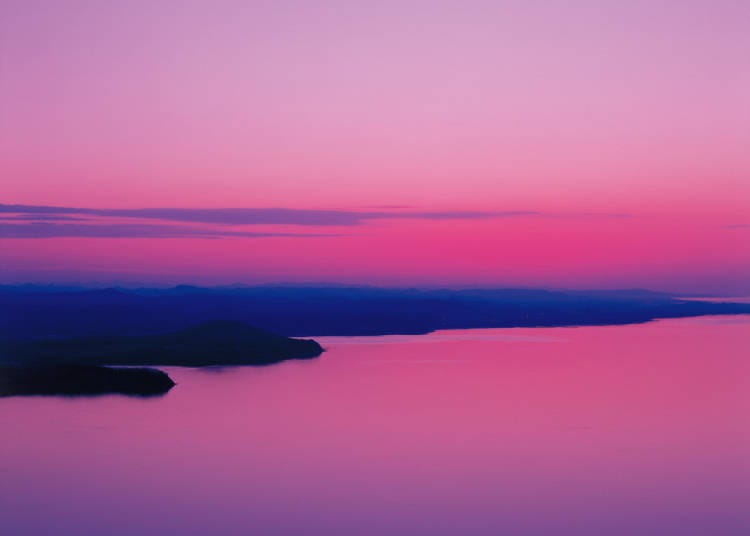
Straddling the cities of Kitami, Yubetsu, and Saroma lies Saroma Lake, the largest brackish lake in Japan. The Wakka Primeval Flower Garden is located on the sandbar between the Sea of Okhotsk and Lake Saroma, which lies in the town of Tokoro, Kitami City on the northeast bank of Lake Saroma.
This flower garden stretches out over approximately 700 hectares, and houses about 300 different species of plants including endemic species of Hokkaido that bloom from spring through autumn. It is about 50 minutes by car from Abashiri via National Highway Route 238.
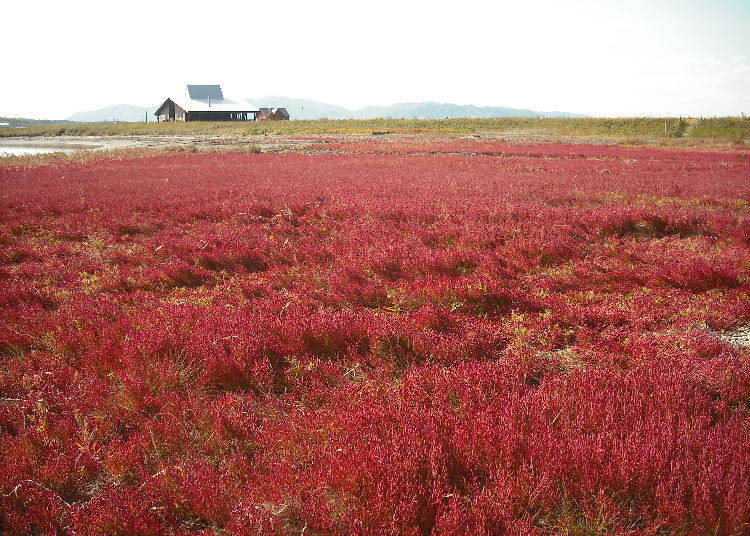
The coral grass colony is one of the autumn specialties of the Wakka Flower Garden, which you will find about a 10-minute walk into the park from the Saromako Wakka Nature Center. There is a wooden path here as well, allowing you to walk along and see it up close.
-
Saromako Wakka Nature Centerサロマ湖ワッカネイチャーセンター
- Address Sakaeura-242-1 Tokorocho, Kitami, Hokkaido 093-0216
Map Code: 525 761 663*37
Cape Kimuaneppu: Dyed Red with Sunset and Coral Grass
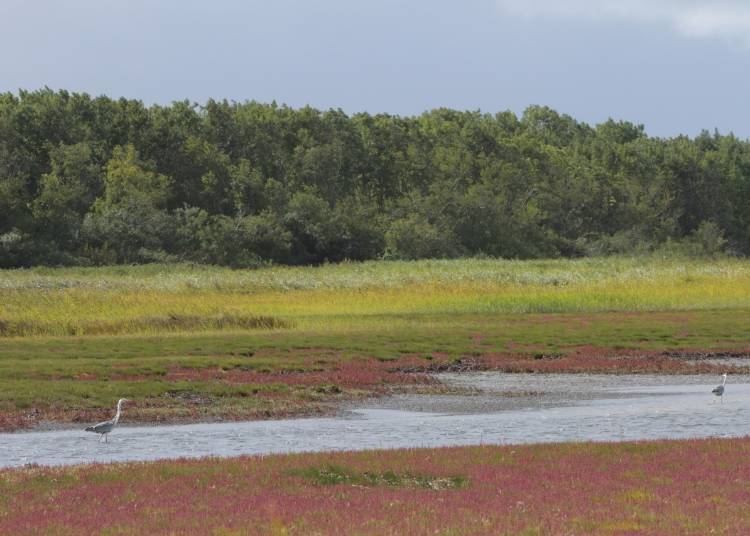
Cape Kimuaneppu protrudes from the southeast shore of Lake Saroma like a terrace, and is located about an hour away from Abashiri via Route 238. Though not as expansive as the others, you can still see the beautifully colored red earth carpeted in coral grass.
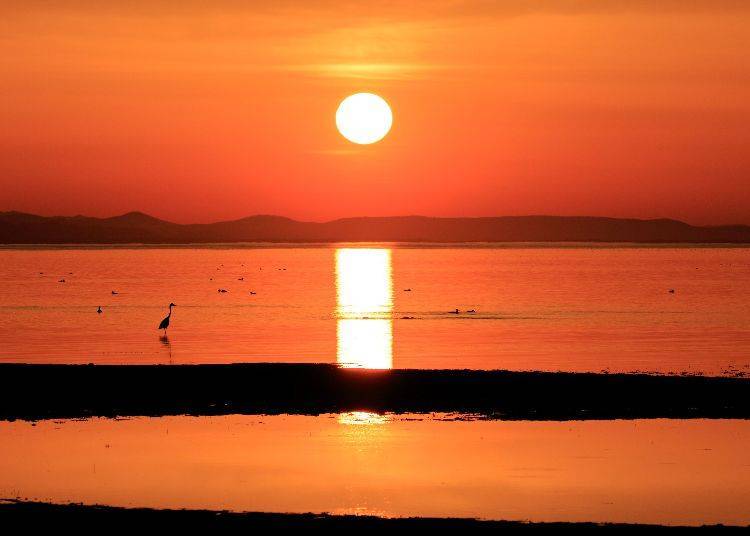
Cape Kimuaneppu is also a popular scenic spot for watching the sunset over Lake Saroma. Many people also enjoy the outdoor camping areas, which are open until mid-October. The color of the coral grass is amplified by the amber sunset, making this a magnificent scenery you will not want to miss!
-
Cape Kimuaneppuキムアネップ岬
- Address Horoiwa, Saroma, Tokoro District, Hokkaido 093-0422
Map Code: 525 664 658*55
Lake Komuke: Nature Untouched

About 100 kilometers northwest of Abashiri lies another field of coral grass at Lake Komuke, Monbetsu City. A spot barely touched by tourism, it has completely retained its natural wetland landscape. Though a bit more tranquil and toned-down than other areas, this spot is nonetheless the kind of stunning scenery you could only find in Hokkaido.
Lake Komuke is also known locally as a paradise for wild birds, and is home to about 200 different species. There is also a motorhome campsite in the area, open until the end of October.
-
Lake Komukeコムケ湖
- Address Mombetsu, Hokkaido
Protecting the Precious Autumn Landscape
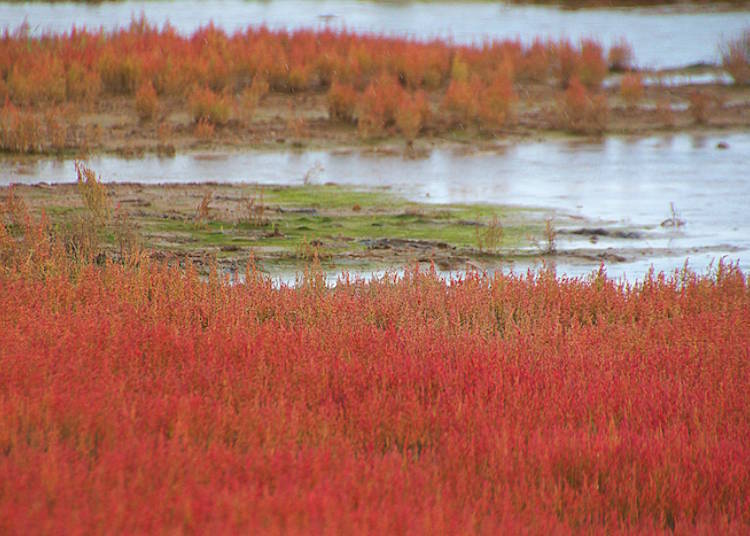
An annual plant, coral grass grows a new colony every year. However, just like the wetlands of Lake Notoro, there is the risk that this habitat may shrink as a result of wetland drying, changes in soil composition, weather and climate change, and the like. Because of this, coral grass has been designated an endangered species by the Ministry of the Environment.
Thankfully, being such a beloved plant as well as a familiar and popular autumn attraction, there have been many conservation efforts made to help revitalize these habitats, even in areas where colonies can no longer be seen.
To do your part, simply follow the rules: stay along the paths when viewing up close, and even if you come to an area where you can enter freely, avoid stepping on them at all costs!
Text by: Minna no Kotobasha
Minna no Kotoba Sha is a production company founded by an editor with extensive experience in editing local magazines in Sapporo. For over 20 years, our team has conducted research and written articles across Hokkaido, with Sapporo as our primary hub. Our diverse portfolio includes the production of various books such as travel guides, informational magazines, and collections showcasing the picturesque landscapes of Hokkaido. Comprised entirely of women, the team at Minna no Kotoba Sha boasts diverse interests, including a passion for travel, culinary delights, and alcoholic beverages. The scope of our communication efforts spans a wide range, covering everything from introducing notable restaurants to providing coverage of local events and sharing stories of leisure experiences.
- Area
- Category
*Prices and options mentioned are subject to change.
*Unless stated otherwise, all prices include tax.
Popular Tours & Activitiess
Recommended places for you
-

Sapporo Clock Tower
Landmarks
Sapporo / Chitose
-
Appealing

Asahiyama Zoo
Zoos, Aquariums & Botanical Gardens
Asahikawa
-
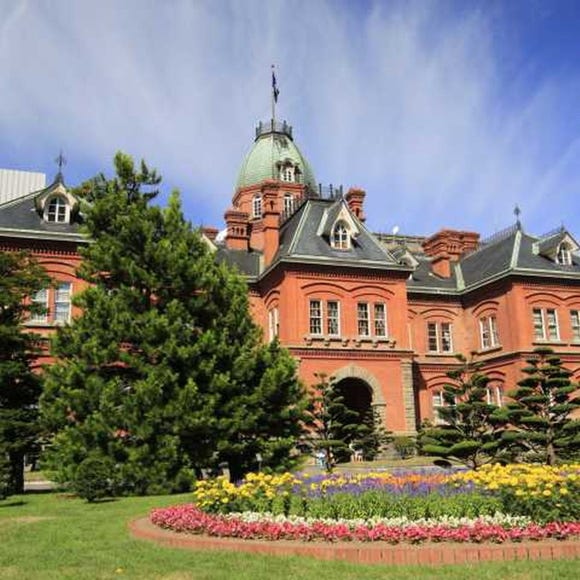
Former Hokkaido Government Office Building (Red Brick Office)
Other Historic Sites
Sapporo / Chitose
-
Appealing

Otaru Canal
Rivers, Lakes & Canyons
Otaru
-
Appealing

Rukku and Uohei
Izakaya
Sapporo / Chitose
-

LakeAkan
Rivers, Lakes & Canyons
Abashiri
-

Beyond Hakodate and Matsumae: Enjoy the Hidden Gems of Hokkaido’s Donan Area
-

7 Iconic Hokkaido locations that will make your Instagram shine
by: Himanshi Shah
-
Ad

Cycling Through Hokkaido: Discover the Beauty of Memuro and the Tokachi Plains
-
Ad

Sapporo SATUDORA Shopping Guide: Get Souvenirs, Medicine & More at This Iconic Drugstore (Special Deal Inside!)
-
Ad

Smart Ways to Avoid Crowds and Enjoy a Safe, Comfortable Trip to Noboribetsu Onsen
-

Expert-Recommended: 9 Hakodate Hotels Serving Up the Best Breakfasts in Town
by: Nobuka Kawashima
-

Top 5 Things to Do Around Lake Toya: Hokkaido's Land of Inspiring Views and Delectable Sweets!
-

JR Edition: Visit all of Tokyo in one Day with the Tokyo Metropolitan District Pass!
-

Noboribetsu Jigokudani: Guide & Best Things to Do in Hokkaido's Mysterious 'Hell Valley'!
-

10 Fun Activities and Magical Places in Furano - According to a Singaporean Expat
-

Healthcare in Japan for Tourists: What to Do When You Get Sick or Injured in Japan
-

6 Most Scenic Spots Around Mount Yotei, Hokkaido: Gorgeous Sunflowers & More!
- #best sushi hokkaido
- #things to do hokkaido
- #best ramen sapporo
- #what to bring to japan
- #new years in tokyo
- #what to buy in ameyoko
- #japanese nail trends
- #what to do in odaiba
- #onsen tattoo friendly tokyo
- #daiso
- #best sweets otaru
- #japanese fashion culture
- #best nature furano
- #japanese convenience store snacks
- #best japanese soft drinks
















